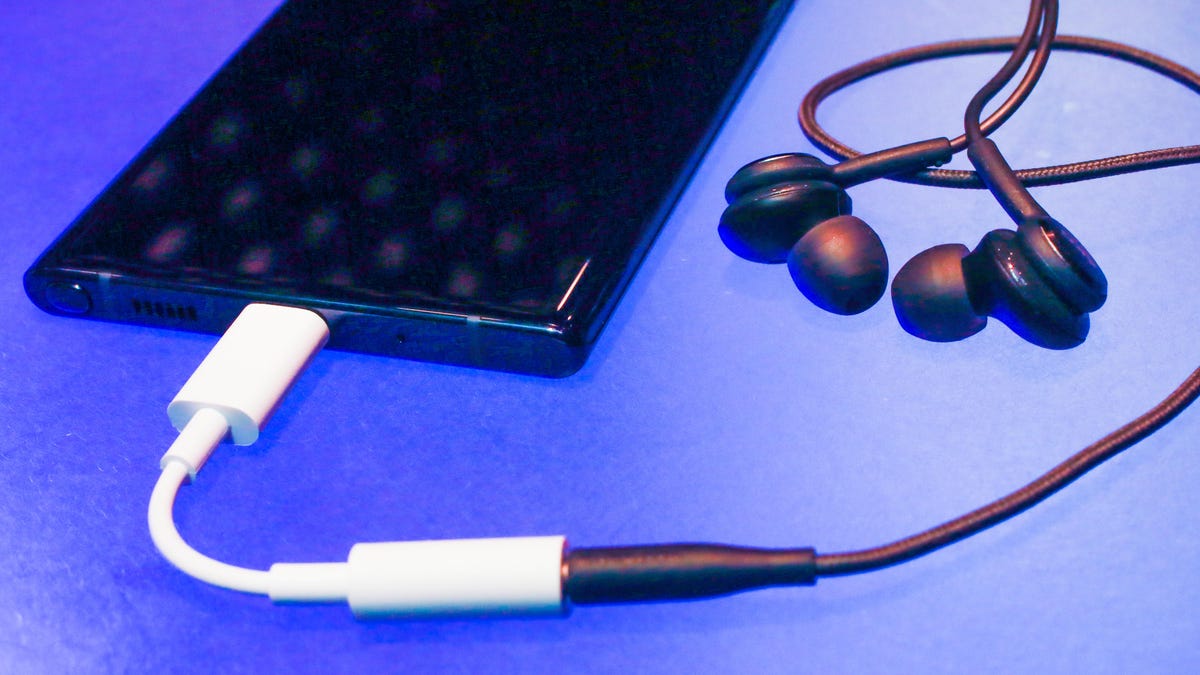Samsung Galaxy Note 10 removes the headphone jack signaling the end of an era
Commentary: Don't worry. There's always Bluetooth and dongles.

There isn't a headphone jack on the Galaxy Note 10 and USB-C dongles are sold separately.
When the Galaxy Note 10 was announced on Wednesday, Samsung talked about its new design, upgraded cameras and even introduced a second, larger model called the Note 10 Plus. But one thing that was never mentioned (aside from the Galaxy Fold) was the fact that there was no longer a headphone jack on the Galaxy Note. A slide shown across the cavernous screen of the Unpacked event stage showed the bottom of the Note 10 with its USB-C port, S-Pen, and speaker grill. Absent were any signs of a headphone jack.
If the Galaxy Note 9 launched without one a year ago, this would have been huge news. But in 2019, when Apple doesn't sell a single new iPhone model with a headphone jack and companies like Google , OnePlus and Huawei have removed them from their flagships, it's not surprising that the Galaxy Note 10 doesn't have one. More importantly, this move by Samsung signals the end of the phone's headphone jack as we know it. I just wish there was an equally universal standard replacing it that was also affordable.
We can't pour one out for the 3.5-millimeter audio jack just yet because brands like LG and Motorola still have them on new phones. Motorola removed the headphone jack from its Moto Z phone in 2016 only to bring it back on this year's Moto Z4 . But having Samsung remove it from the Note 10 is like turning the first page of the last chapter of a book. It's now inevitable that most phones will never have them again.
The headphone jack was one of the longest lasting and most widely used standards in consumer goods and gadgets . You can plug the same pair of headphones into a Galaxy Note 9 that you can into an iPhone 6S , Nintendo Switch, Mac or PC laptop as well as literally hundreds of other devices. Decades before the iPod and the rise of smartphones, the only dongles needed for headphones were either a quarter-inch adapter for higher end stereo systems or a 2.5-millimeter adapter found in small electronics such as a pocket transistor radio.
Dongles and adapters are now commonplace especially if you hope to use the same pair of headphones on multiple devices. And as annoying as dongles are, the inconvenience of using them obscures the fact that there isn't a new single universal standard being adopted by companies in lieu of the headphone jack.
Apple's wired earphones have a lightning connector on them while nearly all Android phones use either USB-C headphones or a USB-C dongle. But USB-C isn't the same across phones because at some point audio needs to be converted from a digital signal into an analog one. Sometimes that happens within a smartphone, as with the LG G8 and V50 which both have a built-in 32-bit digital-to-analog converter (DAC). Other times it can happen in the dongle itself. To complicate things further, some phone makers have introduced proprietary features in their USB-C port. HTC's noise-cancellation features, for example, mean the USB port is only compatible with an HTC dongle. And I won't even get into active or passive adapters.
Related Links
Then there's Bluetooth. Everything, even my toothbrush, has Bluetooth. So it's definitely universal. And it could be a good alternative to the 3.5-millimeter jack. It definitely gets bonus points for eliminating cables. But the problem with Bluetooth headphones isn't necessarily the connection or audio quality, which seems to be improving every year. It's the price.
Apple AirPods cost $199 -- the case alone costs $79. Google has Pixel Buds , but those cost $159. And Samsung has its Galaxy Buds which cost $130. But where's the "cheap" pair of Bluetooth headphones that Apple or Samsung includes in the box?
At Walgreens, you can snag a pair of Bluetooth neck sport earbuds for $16. I can't imagine they sound as good as AirPods, which have decent audio quality but aren't great. You could literally buy a dozen pairs of Walgreens cheap-o Bluetooth earbuds for the cost of a single pair of AirPods. Do AirPods sound 12 times better? Probably not.
But let's go back to Samsung's Unpacked event on Wednesday. The company claimed the decision to not include a headphone jack was to free up physical space inside the phone for more battery capacity. Samsung also said that 70% of Galaxy S and Note owners didn't use the headphone jack as more people shift toward wireless earbuds. But let's take a moment and salute the significance of Samsung finally retiring the headphone jack. Since its debut in the 1950s, this small piece of technology has had a pretty good run.

